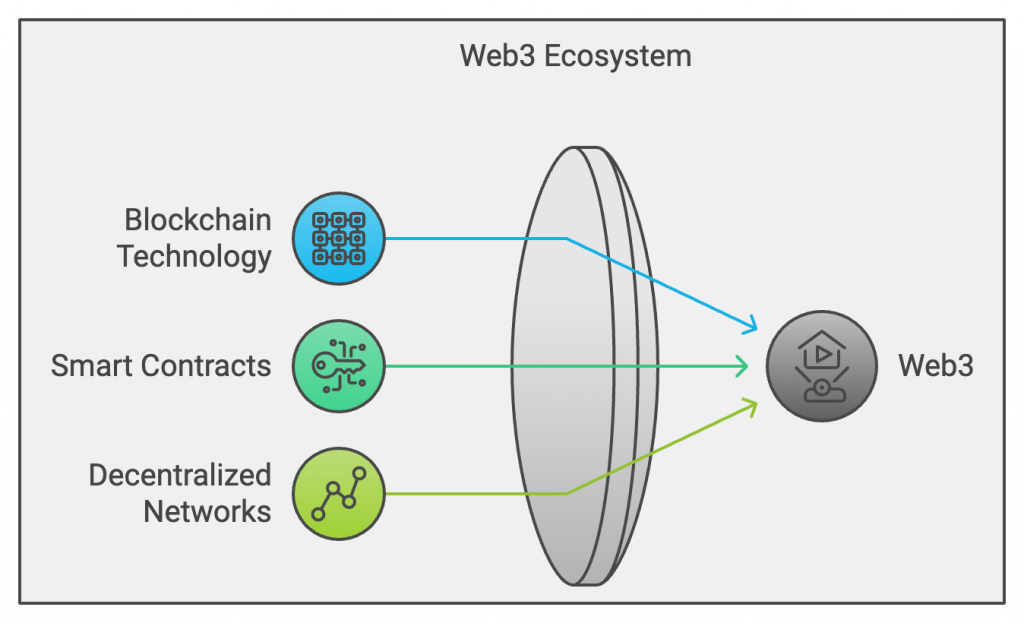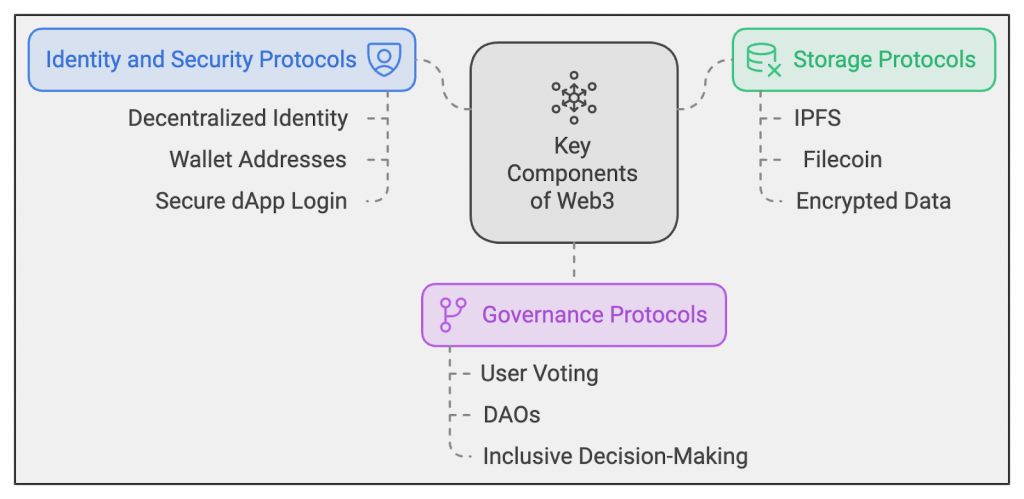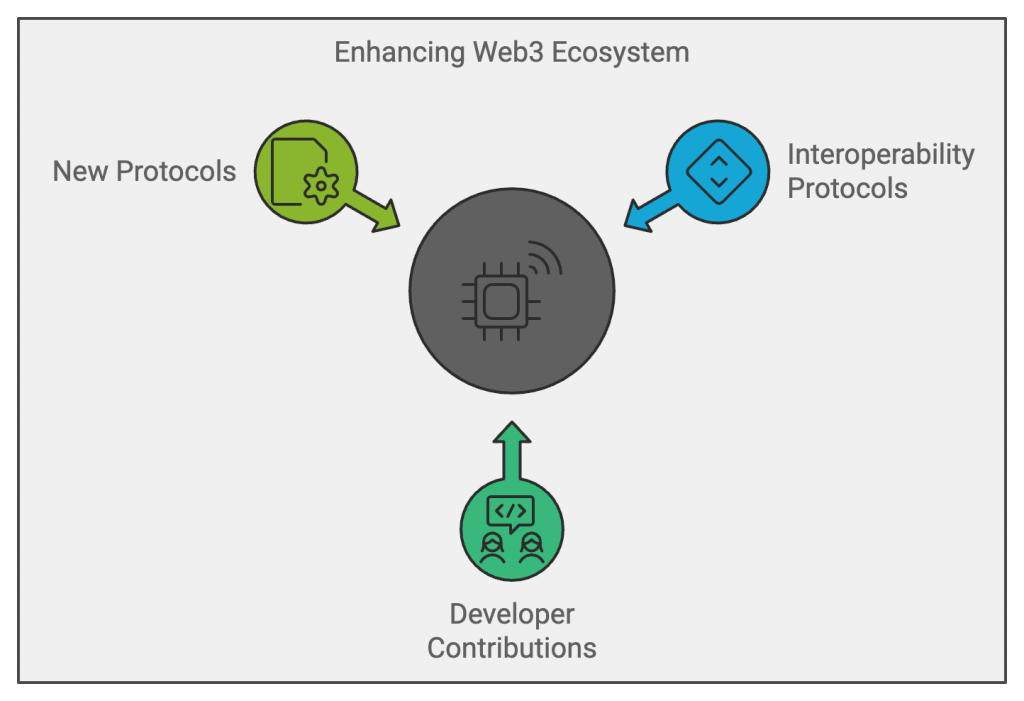A Detailed Guide To Web3 Protocols
Before we dive into the nuts and bolts of Web3 protocols, let’s take a quick trip back in time. Remember the early days of the internet, Web1? It was all static pages, where you could only read information. Then came Web2, which brought us social media, interactive websites, and e-commerce. But as impressive as Web2 is, big companies control it – think Facebook, Google, and Amazon.
Now, Web3 is here to change the game. It’s decentralized, meaning there’s no middleman controlling everything. Instead, power is returned to the users (that’s us!). And guess what? Web3 protocols are what make this decentralized magic happen.
What Is Web3?
Web3 isn’t just a fancy buzzword; it’s a new era of the internet. Think of it as the internet but with superpowers. Unlike Web2, where companies store your data and make decisions, Web3 is all about decentralization. Users own their data, control their identity, and participate in systems without a central authority.

So, what’s the secret sauce behind Web3? That’s where protocols come in.
Core Web3 Protocols
Blockchain Technology
At the heart of Web3 is blockchain technology. Think of blockchain as a digital ledger, a book that records transactions in a way that can’t be altered. Every time something happens, it gets recorded on this blockchain, and the information is visible to everyone – but without revealing your personal details. What’s incredible is that it’s completely decentralized. No one person or entity is in control, making it secure and transparent.
Examples: Ethereum, Solana, and Bitcoin are top-rated blockchains powering the Web3 ecosystem.
Smart Contracts
Here’s where things get interesting: smart contracts. Smart contracts are digital agreements that run on the blockchain and execute automatically when certain conditions are met. Imagine renting an apartment, but you enter a smart contract instead of signing papers. Once the rent is paid, the contract automatically unlocks your keys – no landlord needed. Gorgeous, right? Smart contracts eliminate middlemen, making processes faster and more reliable.
Decentralized Networks
Unlike Web2’s centralized servers, Web3 operates on decentralized networks. In Web2, companies like Google control massive servers and store all your data. In Web3, data is stored across a bunch of independent nodes (consider them to be small computers) worldwide. This makes the system much more resilient and secure because there’s no single point of failure. Censorship? A thing of the past!

Key Components Of Web3
Identity And Security Protocols
In Web3, your digital identity isn’t tied to an email or social account controlled by Facebook or Google. Instead, your identity is decentralized and frequently linked to a wallet address (like MetaMask). Identity protocols ensure you can securely sign in to dApps (decentralized applications) without revealing too much information about yourself. Think of it as controlling your digital ID, not some big tech company.
Storage Protocols
Data is king, right? Well, in Web3, storage protocols are what keep your data decentralized. Forget relying on Google Drive or Dropbox. With storage protocols like IPFS and Filecoin, your data is spread across multiple locations, encrypted, and securely stored. This means no single server can go down and take your files with it.
Governance Protocols
What’s cool about Web3 is that it’s not just decentralized in terms of tech – it’s decentralized in decision-making. Enter governance protocols. These protocols give users a say in how a decentralized project evolves. Instead of a CEO calling the shots, users can vote on proposals, policies, and updates through DAOs (Decentralized Autonomous Organizations). It’s like being a shareholder but in a much more inclusive and transparent way.

How Web3 Protocols Power dApps
DApps And Their Role in Web3
DApps, or decentralized applications, are Web3’s version of apps, but with a twist. Instead of running on centralized servers like Web2 apps (think Instagram or Amazon), DApps run on decentralized networks powered by smart contracts. You don’t need to trust a company to keep the app running – they just work autonomously. Top-notch protocols like Ethereum and Solana provide the foundation for these apps, enabling developers to build all kinds of tools, from decentralized exchanges (DEXs) to NFT marketplaces.
Decentralized Finance (DeFi)
Ever wanted to be your bank? Welcome to Decentralized Finance (DeFi). DeFi protocols allow you to borrow, trade, and earn interest on your crypto assets without needing a bank. Some of the most excellent DeFi projects are built on protocols like Uniswap and Aave, which allow users to trade assets or earn passive income through lending pools. The best part? No middlemen, no banks – just you and the blockchain.

Interoperability And Evolution Of Web3 Protocols
Interoperability Between Blockchains
One of the challenges Web3 faces is interoperability. There are plenty of blockchains (Ethereum, Solana, Polkadot, etc.), but they don’t always talk to each other. This is where interoperability protocols, like Polkadot and Cosmos, come in. They create bridges between blockchains, allowing them to share data and assets. It’s like having apps on your iPhone and Android that work together – mind-blowing, right?
What’s Next For Web3 Protocols
We’re just scratching the surface with Web3. The future looks bright as more developers come on board and more protocols are created. Think of new possibilities in gaming, virtual worlds, and even decentralized social networks. With Web3, the internet is evolving into a space where users have more control, ownership, and opportunity. So, get ready – this is just the beginning!

Conclusion
Web3 protocols are the backbone of the decentralized future. Whether it’s blockchain technology, smart contracts, or decentralized networks, these protocols enable the Web3 ecosystem to thrive. From powering dApps to reshaping finance with DeFi, Web3 is fundamentally changing how we interact with the internet. The best part? It’s only going to get better. So, keep exploring, keep learning, and welcome to the Web3 world!



